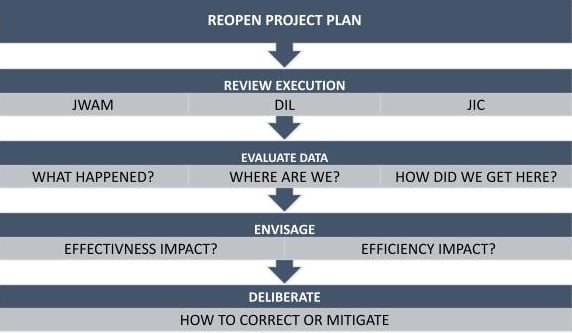“As lawyers, we are problem solvers so roadblocks and frustrations are going to happen. We should never fear roadblocks — we should expect them and attack them head on.” — José Gonzalez, EVP& General Counsel, CNA, USA
Things don’t go to plan. They just don’t.
This is true of pretty much every plan there has ever been, from carefully planned plane trips to legal projects. If there’s a storm over the Irish Sea, so long as the pilot detects it and flies around it, then the plane and passengers will get delivered to the right place. The plane will arrive later than planned and use more fuel than budgeted, but these things will be within an Anticipated Range of Outcomes. Indeed this is expected and why extra fuel is carried.
In the same way, if a legal project is beset by something unexpected, correction will depend on how quickly the problem is spotted, and whether the chosen remedy is effective. In short, our success in private practice doesn’t depend on whether things go to plan, it depends on how quickly we spot deviations from plan, and how effectively we correct them.
In manufacturing terms, if you can build a thousand perfect Toyotas on Monday, the chances are you will do it again on Tuesday. The practice of law is not like that. Even if the foundations are correctly established and a well thought out plan is made, legal projects are dynamic, uncertain and event-driven.
The truest test of a lawyer is when things don’t go to plan. It requires the insight to see how the project is being influenced — is it for good or bad — and the ability to manage the situation. This work calls for vigilance, strategic oversight, and, of course, teamwork. The most inexperienced lawyer on the team might see the potential significance of an event, or spot a misstep. That’s the time to gather the group to assess and then decide how to react. That’s just another way of saying that we all need to evaluate data and information.
The Lean Adviser tool for this is called just that, the PET or Project Evaluation Tool.
Here’s how it works.
- Reopen our project plan
- Remind ourselves of all the components
- Review our execution of ‘Just What Matters’ ‘Do It Lean’ and ‘Just In case’
- Evaluate the observed events/data/information versus our plan and our expectation
- What’s happened or not happened?
- Where are we versus where we expected to be?
- How did this come about?
- Is it our plan, our execution or both?
- Envisage what this tells us about the future, in terms of:
- Effectiveness — will we get the client to the right outcome?
- Efficiency — will we do this within budget and on time?
- Deliberate how to correct or mitigate
Of course, following up with appropriate steps comes later. The focus here is just evaluation, and we’ll get to correction in an upcoming lesson. We can see the essence of this in an infographic as below:
Evaluation then, just means trying to bottom out what the data tells us, getting to the root cause of it, and re-planning. This is what we all do, and how we all react. Here is a reminder of the importance of it, and a tool to provide some structure. This way, when you tell the client, as you must, you can add some insight. Clients like that. They like it a lot.














































 Copyright © 2024 ALM Global, LLC. All Rights Reserved.
Copyright © 2024 ALM Global, LLC. All Rights Reserved.